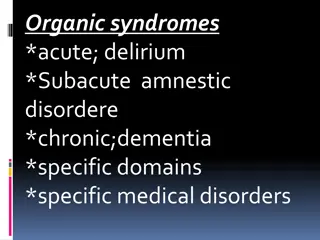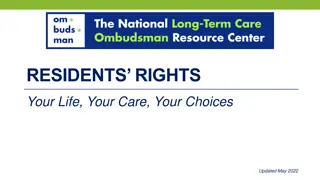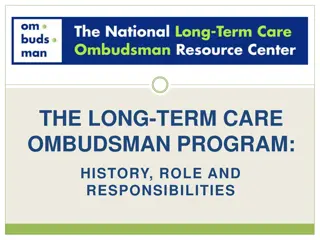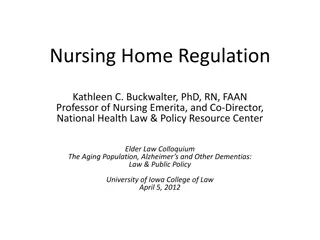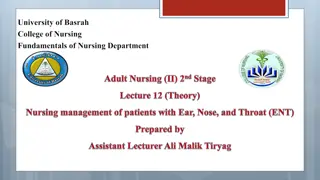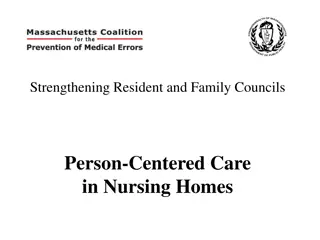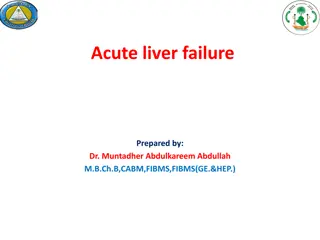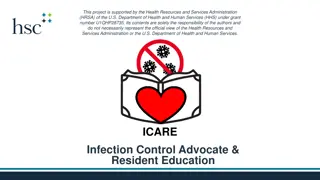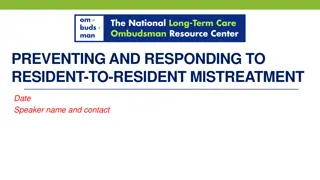Understanding Subacute Care: Types of Residents and Care Settings
Subacute care involves providing specialized care for individuals who require more attention than what typical long-term care facilities can offer. This level of care is provided in settings like hospitals or certain units within long-term care facilities. Residents in subacute care settings need a higher level of care and close monitoring by staff due to their complex medical needs.
Download Presentation

Please find below an Image/Link to download the presentation.
The content on the website is provided AS IS for your information and personal use only. It may not be sold, licensed, or shared on other websites without obtaining consent from the author. Download presentation by click this link. If you encounter any issues during the download, it is possible that the publisher has removed the file from their server.
E N D
Presentation Transcript
26 Subacute Care
26 1. Define important words in this chapter central venous line a type of intravenous line (IV) that is inserted into a large vein in the body. chest tubes hollow drainage tubes that are inserted into the chest to drain air, blood, pus, or fluid that has collected inside the pleural space/cavity. delirium a sudden state of severe confusion due to a change in the body; also called acute confusional state or acute brain syndrome. gastrostomy a surgically created opening in the abdomen and stomach. Subacute Care 2
26 1. Define important words in this chapter intubation the insertion of a plastic tube through the mouth or nose and into the trachea or windpipe in order to place an artificial airway. mechanical ventilator a machine used to inflate and deflate the lungs when a person cannot breathe on his own. nasogastric tube a feeding tube that is inserted through the nose and into the stomach. Subacute Care 3
26 1. Define important words in this chapter percutaneous endoscopic gastrostomy (PEG) tube a tube placed through the abdominal wall into the stomach to deliver liquid nutrients and medications. pulse oximeter device that measures a person s blood oxygen level and pulse rate. sedation the use of medication to calm a person. sepsis a serious illness caused by an infection, usually bacterial, that requires immediate care. Subacute Care 4
26 1. Define important words in this chapter telemetry the application of a cardiac monitoring device that transmits information about the heart rhythm and heart rate to a monitoring station for assessment. total parenteral nutrition (TPN) the intravenous infusion of nutrients in a basic form that is absorbed directly by the cells, bypassing the digestive tract. Subacute Care 5
26 2. Discuss the types of residents who are in a subacute setting Define the following term: Subacute Care mechanical ventilator a machine used to inflate and deflate the lungs when a person cannot breathe on his own. 6
26 2. Discuss the types of residents who are in a subacute setting Remember these facts about subacute settings: Subacute Care A subacute setting is a special unit or facility that is for people who need more care than most long-term care facilities can provide. Hospitals and long-term care facilities may offer subacute care. Residents in subacute care settings need a higher level of care than other residents. They will require more direct care and close observation by staff. 7
26 2. Discuss the types of residents who are in a subacute setting Know the types of residents found in subacute units: Subacute Care Residents who need more care and observation than other residents Residents having had recent surgery and chronic illnesses, such as AIDS and cancer Residents with serious burns, who need special administration of nutrients or medicine, or who need dialysis. 8
26 3. Describe preoperative and postoperative care Follow these guidelines for preoperative and postoperative care: Subacute Care Follow orders for fluid restrictions. Be calm and compassionate and listen to the resident. Store personal items (eyeglasses, hearing aids, etc.) as directed. Provide catheter care as needed. Measure vital signs as directed. Assist with an incentive spirometer as needed. Apply a sequential compression device as ordered. Encourage the resident to follow special diet orders. 9
26 4. List care guidelines for pulse oximetry Define the following term: Subacute Care pulse oximeter device that measures a person s blood oxygen level and pulse rate. 10
26 4. List care guidelines for pulse oximetry Remember these points about the pulse oximeter: Subacute Care Warns of low blood oxygen level before signs develop Normal pulse oximeter reading is 95% and 100%, but it can differ. Report to nurse any change in oxygen levels. 11
26 4. List care guidelines for pulse oximetry Know the care guidelines for pulse oximetry: Subacute Care Tell the nurse right away if alarm sounds. Do not place the sensor on an artificial nail. Be careful when moving and positioning so oximeter does not move or come off. Report difficulty breathing. Report pale, cyanotic, darkening, or grayish skin, or mucous membranes. Report signs of skin breakdown from the device. Check vital signs as ordered, and report changes to the nurse. 12
26 Applying a pulse oximetry device Equipment: pulse oximetry clip-on sensor, cleansing wipe (facility approved) Subacute Care Measure blood pressure and count pulse rate before placing the device if needed. 1. 2. 3. Identify yourself by name. Identify the resident. Greet the resident by name. Wash your hands. Explain procedure to resident. Speak clearly, slowly, and directly. Maintain face-to-face contact whenever possible. Provide for the resident s privacy with a curtain, screen, or door. Using the cleansing wipe, clean the finger or other body area on which the sensor will be placed, following facility policy. Remove sensor from package and place on index finger, toe, or earlobe. The sensor must be placed fully onto the finger or toe; it should not be placed on the tip of the finger or toe. 4. 5. 6. 13
26 Applying a pulse oximetry device 7. Turn on the device. The pulse oximetry reading should appear on the screen quickly. If the device does not seem to be working, make sure the wires on the pulse oximeter are in place and that device is plugged in. Ask resident to not remove or adjust pulse oximetry device. Let him know that he should press the call light if the device dislodges or comes off. Make the resident comfortable. 10. Remove privacy measures. 11. Leave call light within the resident s reach. 12. Wash your hands. 13. Be courteous and respectful at all times. 14. Report any changes in the resident to the nurse. Document procedure (both the pulse and the oxygen saturation) using facility guidelines. Leave the sensor in place, turned on, following the care plan and the nurse s instructions. Subacute Care 8. 9. 14
26 5. Describe telemetry and list care guidelines Define the following term: Subacute Care telemetry the application of a cardiac monitoring device that transmits information about the heart rhythm and heart rate to a monitoring station for assessment. 15
26 5. Describe telemetry and list care guidelines Remember these guidelines for telemetry: Subacute Care Report to nurse if alarm sounds. Check vital signs, as ordered. Report if pads become loose. Do not get the unit, wires, pads, or electrodes wet during bathing. Check for signs of skin irritation under or around pads. Remind resident not to leave the monitoring area. Report change in vital signs, rapid pulse, chest pain or discomfort, shortness of breath, dyspnea, sweating, or dizziness to the nurse. 16
26 6. Explain artificial airways and list care guidelines Define the following term: Subacute Care intubation the insertion of a plastic tube through the mouth or nose and into the trachea or windpipe in order to place an artificial airway. 17
26 6. Explain artificial airways and list care guidelines REMEMBER: Subacute Care An artificial airway is needed when the airway is obstructed due to illness, injury, secretions, or aspiration, and sometimes is needed when a person has surgery. Some residents who are unconscious will need an artificial airway. An artificial airway is inserted during a procedure called intubation. 18
26 6. Explain artificial airways and list care guidelines Remember these guidelines for artificial airways: Subacute Care Tell nurse if tubing comes out. Follow orders for positioning. Check vital signs as ordered. Perform oral care often, at least every two hours. Report biting or tugging on the tube. Write notes, draw pictures, and use communication boards and hand and eye signals if resident cannot speak. 19
26 6. Explain artificial airways and list care guidelines Guidelines for artificial airways (cont d): Subacute Care Be supportive and encouraging. Do not move ore remove spare artificial airway tubes or other equipment from the bedside. Report signs of respiratory distress, including wheezing or other unusual breathing sounds or difficulty breathing; cyanosis, pale, gray, or darkening skin or mucous membranes; change in vital signs; drainage; secretions in tubing; or nervousness or anxiety. 20
26 7. Discuss care for a resident with a tracheostomy A tracheostomy is a common type of artificial airway. The tracheostomy tube is held in place by a cuff that attaches to the end of the device in the trachea. The cuff prevents the accidental aspiration of food or fluids. Subacute Care 21
26 7. Discuss care for a resident with a tracheostomy Know the reasons why tracheostomies are necessary: Subacute Care Obstruction Cancer Infection Severe injuries Serious allergic reaction Coma Facial burns Gunshot wounds To prevent aspiration in an unconscious person 22
26 7. Discuss care for a resident with a tracheostomy Critical Thinking: Conversation Starter Subacute Care How would it feel to have an artificial airway and be unable to speak? 23
26 7. Discuss care for a resident with a tracheostomy REMEMBER: Subacute Care Nursing assistants muse use alternate methods of communication if the resident cannot speak. It is important to answer call lights promptly. 24
26 7. Discuss care for a resident with a tracheostomy Critical Thinking: Conversation Starter Subacute Care Even though nursing assistants do not perform tracheostomy care or suctioning, why is careful observation and reporting so important? 25
26 7. Discuss care for a resident with a tracheostomy Remember the following guidelines for tracheostomies: Subacute Care Answer call lights promptly. Use alternate methods of communication. Follow orders for positioning. Do not tire resident. Check vital signs as ordered. Inspect ties or tape often. 26
26 7. Discuss care for a resident with a tracheostomy Guidelines for tracheostomies (cont d): Subacute Care Keep the dressing dry, and do not cover the tracheostomy opening. Report kinks or disconnected tubing. Perform oral care often, at least every two hours. Observe for mouth sores, cracks, breaks or sores on skin. Provide careful skin care. Observe for pale, bluish, or darkening skin or mucous membranes. 27
26 7. Discuss care for a resident with a tracheostomy Guidelines for tracheostomies (cont d): Subacute Care Do not move spare tracheostomy tubes or bag valve mask. Report disconnected tubing; signs of respiratory distress, including wheezing or other unusual breathing sounds or difficulty breathing; cyanosis, pale, gray, or darkening skin or mucous membranes; change in vital signs, especially respiratory rate; mouth sores or discomfort; cracks, breaks, or sores on the skin; or loose or wet tape or dressings. 28
26 8. Describe mechanical ventilation and explain care guidelines Define the following term: Subacute Care sedation the use of medication to calm a person. delirium a sudden state of severe confusion due to a change in the body; also called acute confusional state or acute brain syndrome. 29
26 8. Describe mechanical ventilation and explain care guidelines Remember these points about delirium: Subacute Care Causes: dehydration, malnutrition, fever, pain, poisons, alcohol and drug use, prescribed medication, hypoxia, head injury, illness, infections Symptoms: disorganized thinking; inability to concentrate; problems with speech, agitation, anger, or irritability; drowsiness or sleep disturbances; decrease in short-term memory; lack of attention span; disorientation; changes in consciousness; decrease in ability to move; pulling out tubing; hallucinations Treatment: medication, emergency care, hospital stay 30
26 8. Describe mechanical ventilation and explain care guidelines Know these points about mechanical ventilators: Subacute Care Resident will not be able to speak, which can greatly increase anxiety. Being on a ventilator has been compared to breathing through a straw. Be supportive. Enter the room so the resident can see you often. Use other methods of communication. Act and speak as if resident can understand everything, even if he or she is unconscious or heavily sedated. Being on a ventilator puts a person at a higher risk for developing complications, including a type of pneumonia, considered a ventilator-associated event (VAE). 31
26 8. Describe mechanical ventilation and explain care guidelines Remember these care guidelines for residents with mechanical ventilators: Subacute Care Wash hands thoroughly. Answer call lights promptly. Tell nurse right away if alarm sounds. Report kinks or disconnected tubing right away. Report biting or pulling on the tube. Give oral care often. Report mouth sores or discomfort. Reposition at least every two hours. Follow positioning orders. 32
26 8. Describe mechanical ventilation and explain care guidelines Care guidelines for residents with mechanical ventilators (cont d): Subacute Care Give regular skin care to prevent pressure ulcers. Allow time for rest. Follow orders for ROM exercises. Be patient during communication. Provide emotional support. 33
26 8. Describe mechanical ventilation and explain care guidelines Care guidelines for residents with mechanical ventilators (cont d): Subacute Care Do not move spare artificial airway tubes or bag valve masks. Report the alarm sounding; tubing moves or disconnects; signs of respiratory distress; secretions in tubing; mouth sores or discomfort, cracks, breaks, or sores on the skin; swollen or red area of an extremity; change in vital signs; nervousness or anxiety; or depression. 34
26 8. Describe mechanical ventilation and explain care guidelines Case Study Mrs. G is on a mechanical ventilator. She is sedated, but she is conscious. She bites on her tube sometimes and looks anxious when the NA enters the room. What can the NA do to reassure Mrs. G? What care can the NA give to help increase Mrs. G s comfort? Subacute Care 35
26 8. Describe mechanical ventilation and explain care guidelines Define the following term: Subacute Care sepsis a serious illness caused by an infection, usually bacterial, that requires immediate care. 36
26 8. Describe mechanical ventilation and explain care guidelines Know the signs of sepsis: Subacute Care Elevated heart rate and respiratory rate Slightly elevated temperature or low temperature Chills Excessive sweating Feeling of sickness or weakness 37
26 8. Describe mechanical ventilation and explain care guidelines Signs of sepsis (cont d): Subacute Care Low blood pressure Decreased urine output Headache Skin rash Shortness of breath Confusion or change in mental status 38
26 8. Describe mechanical ventilation and explain care guidelines REMEMBER: Subacute Care Nursing assistants should be familiar with residents normal vital signs in order to better recognize changes. This will help them notice the early symptoms of sepsis. 39
26 8. Describe mechanical ventilation and explain care guidelines Know these points about suctioning: Subacute Care Necessary when a person has increased secretions that he cannot expel Suctioning can be performed orally, nasally, and through the trachea and bronchi. Nursing assistants do not perform suctioning. Suction comes from wall or pump and bottle collects suctioned material. Sterile water or sterile saline is used to rinse suction catheter. Signs of respiratory distress are gurgling, high respiratory rate, shortness of breath, dyspnea, pallor, or cyanosis. 40
26 9. Describe suctioning and list signs of respiratory distress Remember these guidelines for assisting with suctioning: Subacute Care Follow Standard Precautions. Monitor vital signs closely. Report signs of respiratory distress immediately. Observe for pale, bluish, or darkening skin or mucous membranes. Answer call lights promptly. Follow orders for positioning. 41
26 9. Describe suctioning and list signs of respiratory distress Guidelines for assisting with suctioning (cont d): Subacute Care Place pad or towel under chin before suctioning. Give oral and nasal care after suctioning. Give emotional support during difficult periods. Report signs of respiratory distress, including wheezing or other unusual breathing sounds or difficulty breathing; cyanosis, pale, gray, or darkening skin or mucous membranes; change in vital signs, especially respiratory rate; change in the color, amount, or quality (thickness/thinness) of secretions coughed up; or nervousness or anxiety. 42
26 9. Describe suctioning and list signs of respiratory distress Define the following term: Subacute Care chest tubes hollow drainage tubes that are inserted into the chest to drain air, blood, pus, or fluid that has collected inside the pleural space/cavity. 43
26 10. Describe chest tubes and explain related care Know these points about chest tubes: Subacute Care Can be inserted at bedside or during surgery Drain air, blood, pus, or fluid Allow a full expansion of the lungs Conditions requiring chest tubes include pneumothorax, hemothorax, empyema, surgery, injuries Chest tube is connected to bottle of sterile water. System must be airtight when attached to suction. 44
26 10. Describe chest tubes and explain related care Remember these guidelines for chest tubes: Subacute Care Report signs of respiratory distress and pain. Check vital signs as directed and report changes. Be aware of where chest tubes are located. Keep drainage system below level of chest. Keep drainage containers upright and level. Keep tubing coiled neatly. Report clots in tubing. 45
26 10. Describe chest tubes and explain related care Guidelines for chest tubes (cont d): Subacute Care Observe chest drainage for amount, color, and consistency. Observe dressings for drainage, saturation, or bleeding. Do not remove equipment in the area. Follow orders for positioning. Encourage deep breathing exercises. Provide rest periods. 46
26 10. Describe chest tubes and explain related care Guidelines for chest tubes (cont d): Subacute Care Follow fluid orders and measure I&O carefully. Report disconnected tubing; any signs of respiratory distress and cyanosis; changes in vital signs; change in oxygen level or if pulse oximetry alarm sounds; complaints of pain; coughing up blood; warmth, redness, swelling, sores, or pus; an increase or decrease in bubbling in the drainage system; kinks or clots in the tubing; any change in the amount, color, consistency, or odor of chest drainage; wet or loose dressings; or signs of subcutaneous emphysema (crepitus), such as bulging of the skin or skin that produces a crackling sound. 47
26 10. Describe chest tubes and explain related care Define the following terms: Subacute Care nasogastric tube a feeding tube that is inserted through the nose and into the stomach. percutaneous endoscopic gastrostomy (PEG) tube a tube placed through the abdominal wall into the stomach to deliver liquid nutrients and medications. gastrostomy a surgically created opening in the abdomen and stomach. 48
26 11. Describe alternative feeding methods and related care REMEMBER: Subacute Care When a person is unable to consume food normally due to disease or injury, other methods are used. When a person has difficulty swallowing or is unable to swallow, he may be fed through a tube. 49
26 11. Describe alternative feeding methods and related care REMEMBER: Subacute Care Nursing assistants do not insert tubes, give the feedings, or clean or suction the tubes. Your role is assisting the nurse and positioning the resident. Careful observation for problems and changes is important. 50


